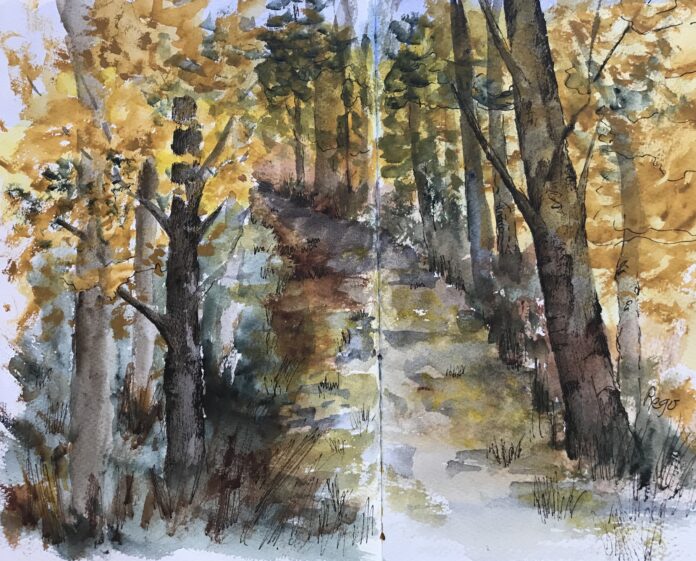BY LESLIE REGO

In the sixties, when my father visited London, he stayed at The Cadogan Gardens. I know this because I received letters from him written on the hotel’s stationery. When I visited London with my kids, I also stayed at The Cadogan Gardens, in honor of my father. I have been reading “The Secret Lives of Color,” by Kassia St. Clair, and in the chapter on yellow, I was fascinated that Oscar Wilde was arrested outside of the Cadogan Hotel in London in 1895. The headline in the Westminster Gazette was, “Arrest of Oscar Wilde, Yellow Book Under His Arm.” Apparently, in that time period, sensationalist literature was pressed between bright yellow covers!
Throughout history there has always existed the good and the bad with the color yellow. The pigment gamboge comes from the sap of the Garcinia tree in Cambodia. Hollow bamboo is used to catch the sticky secretion. It takes over a year to gather a small amount and then the sap must harden in order for it to be used as a colorant. Besides being used as a paint, gamboge was also a powerful diuretic. Workers who crushed the hardened gamboge at the Winsor & Newton artist supply shop had to excuse themselves regularly to rush to the toilet.
Another artist color, Naples yellow, was so unstable it could quickly descend into black. Indian yellow, from India, was thought to be extracted from the urine of cows fed mango leaves, which produced an extraordinarily brilliant yellow pee.
In China, yellow was kept for the emperors who dressed in yellow silk clothes. Royal palaces had yellow roofs. Common people were forbidden from wearing any shade of yellow.
In 1903, Katherine Augusta Carl, an American artist trained in Paris, traveled to the Forbidden City in China. Once there, she was instructed to paint the portrait of the empress dowager Cixi, a former concubine who became so powerful she ruled China for 40 years. Cixi’s gown was of shimmering golden silk. At precisely 11 a.m., all 85 clocks in the throne room began to chime. This was the moment the royal augers had prescribed as the most auspicious time for the portrait painting to begin. Hands shaking, Katherine Augusta Carl took deep breaths and dipped her brush into the imperial yellow paint.
In Idaho, the aspen tree is attired in a golden garment that shimmers throughout the autumn. The leaves are the filament that binds the cloth together, weaving the most regal garb of any royalty anywhere.
(Many thanks to Kassia St. Clair, the author of “The Secret Lives of Color”).
Leslie Rego is an Idaho Press Club award-winning columnist, artist and Blaine County resident. To view more of Rego’s art, visit leslierego.com.



